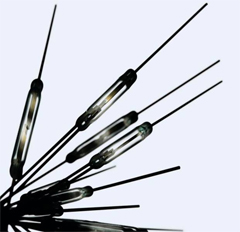Standex-Meder has a long history of developing and producing reed switches to solve unique customer challenges. We offer a wide range of reed switches from the smallest reed switch in the world - to custom engineered products designed for extreme conditions such as temperature, radiation, humidity, dirty environments and more.
Together with our strong partner OKI Sensor Device Corporation from Japan we have a strong global alliance with the capacity to develop and produce value added packaging for your customized product solutions.
Characteristics of Reed Switch
The Reed Switch was first invented by Bell Labs in the late 1930s. However, it was not until the 1940s when it began to find application widely as a sensor and a Reed Relay. Here it was used in an assortment of stepping/switching applications, early electronic equipment and test equipment. In the late 1940s Western Electric began using Reed Relays in their central office telephone switching stations, where they are still used in some areas today. The Reed Switch greatly contributed to the development of telecommunications technology.
Over the years several manufacturers have come and gone, some staying longer than they should have, tainting the marketplace with poor quality, and poor reliability. However, most of the manufacturers of Reed Switches today produce very high quality and very reliable switches. This has given rise to unprecedented growth.
Today Reed Switch technology is used in all market segments including: test and measurement equipment, medical electronics, Telecom, automotive, security, appliances, general purpose, etc. Its growth rate is stronger than ever, where the world output cannot stay abreast with demand.
As a technology, the Reed Switch is unique. Being hermetically sealed, it can exist or be used in almost any environment. Very simple in its structure, it crosses many technologies in its manufacture. Critical to its quality and reliability is its glass to metal hermetic seal, where the glass and metal used must have exact linear thermal coefficients of expansion. Otherwise, cracking and poor seals will result. Whether sputtered or plated, the process of applying the contact material, usually Rhodium or Ruthenium, must be carried out precisely in ultra clean environments similar to semiconductor technology. Like semiconductors, any foreign particles present in the manufacture will give rise to losses, quality and reliability problems.
Over the years, the Reed Switch has shrunk in size from approximately 50 mm (2 inches) to 6 mm (0.24 inches). These smaller sizes have opened up many more applications particularly in RF and fast time domain requirements.
Reed Switch Features:
- 1.Ability to switch up to 10,000 Volts
- 2.Ability to switch currents up to 5 Amps
- 3.Ability to switch or carry as low as 10 nanoVolts without signal loss
- 4.Ability to switch or carry as low as 1 femptoAmp without signal loss
- 5.Ability to switch or carry up to 7 GigaHertz with minimal signal loss
- 6.Isolation across the contacts up to 1015 W
- 7.Contact resistance (on resistance) typical 50 milliOhms (mW)
- 8.In its off state it requires no power or circuitry
- 9.Ability to offer a latching feature
- 10.Operate time in the 100 ms to 300 ms range
- 11.Ability to operate over extreme temperature ranges from âßß55 oC to 200 oC
- 12.Ability to operate in all types of environments including air, water, vacuum, oil, fuels, and dust laden atmospheres
- 13.Ability to withstand shocks up to 200 Gs
- 14.Ability to withstand vibration environments of 50 Hz to 2000 Hz at up to 30 Gs
- 15.Long life. With no wearing parts, load switching under 5 Volts at 10 mA, will operate well into the billions of operations
3 Leading Brands...
Standex-Meder Electronics offers three unique hermetically sealed reed switch offerings, each using a different manufacturing technology. We produce a wide range of reed switch characteristics easily making them the design-in choice to meet applications in several market segments: Instrumentation, Automotive, Security, Medical, Appliances, Telecom, Industrial, and more.
Standex-Switches
The reed switches from Standex are made in a highly automated mechanized environment offering high quality reed switches at some of the lowest costs in the industry. With reed switch lengths ranging from 3.7 mm to 50 mm we are able to meet almost any application worldwide in a competitive manner. The reed switches are easily capable of meeting automotive, security, telecom and the appliance market applications.
Meder-Switches
The reed switches from Meder are made in a mechanized manufacturing environment using a flat lead frame making them ideal for surface mounting. This modern facility uses laser technology for sealing in evacuated chambers. They range in size from 4.0 mm to 10 mm that are capable of switching billions of operations, making them ideal for use in the critically reliable medical industry and automatic test equipment (instrumentation).
OKI-Switches
OKI Reed Switch Device Corporation is the largest manufacturer of reed switches in the world with up to 500 million manufactured yearly. They offer a wide variety of reed switches ranging from 5 mm to 25 mm. All their products are high quality and meet the stringent requirements of the instrumentation, medical, automotive, industrial and telecom markets. They offer high voltage switching and high voltage breakdown requirements.
The very wide offering from all three leading brands allows the engineers to select the best reed switch for a given design, whether its for a reed sensor or reed relay requirement.
In all the facilities, the reed switch leads can be formed into various lead bending and cutting requirements that accommodate a large range of customer applications. Precise tooling is required to prevent any damage to the glass capsule. This value added approach may also include special testing of up to 15 different parameters including dynamic contact resistance. Also the reed switches can be selected in very narrow ranges of magnetic sensitivities as low as 1 ampere turn (AT) increments or 0.1 milli-tesla (mT).
